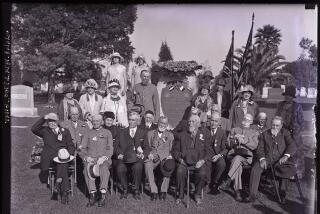Mormons and a massacre: Was Young at all responsible?
- Share via
American Massacre
The Tragedy at Mountain
Meadows, September 1857
Sally Denton
Alfred A. Knopf: 310 pp., $26.95
*
In the 1820s a powerful wind of political and religious unrest swept across the American frontier into which settlers were pouring. In politics, the upheaval brought Andrew Jackson of Tennessee into the presidency in 1828. In religion, it spawned a host of anti-establishment individualistic sects marked variously by mysticism, communistic property ownership, spiritualism and powerful and domineering leaders.
The most successful and enduring of these sects was that of the Mormons, now known as the Church of Jesus Christ of Latter-day Saints. It was founded by Joseph Smith, who received his first of several communications from the angel Moroni on Sept. 21, 1820, in the village of Palmyra in western New York, an area known as the “burned-over district” because of the various religious enthusiasms that had blown through there. Moroni directed Smith to the famous golden tablets, which inspired Smith’s Book of Mormon, his bible for his new religion, a mixture of Christianity, Judaism and the mystical individualism that was a keynote of the period.
His charisma quickly brought followers. They began the long trek west that would end in 1847 in their very own Zion, the Utah Territory. “Industriousness, abundance and envy would fuel the rebuke they faced wherever they settled,” writes Sally Denton, herself of Mormon ancestry, in “American Massacre.”
Even as they celebrated the accumulation of communal wealth, Smith structured his grimly patriarchal and growing separatist band with a priesthood and doctrines sure to inflame the animosity of his neighbors. Polygamy was one; another the notion of “blood atonement,” by which wrongs against the saints, including apostasy, were to be redressed by the spilling of blood, preferably by cutting the throats of the miscreants. To enforce the code of the militant, beleaguered new religion it established, Denton writes, “a secret group of loyalists” -- the Danites, named for the prophet Daniel. They were, if you will -- drawing on the characterization of scholars whom Denton quotes -- Mormon hit squads.
The Mormons’ sense of persecution was quite expectedly inflamed after the murder of Smith by a mob in Nauvoo, Ill., on July 27, 1844. He left 59 wives and numerous children. He also left his successor prophet, Brigham Young, who led the band, now increased by emigrants from England and elsewhere in Europe, to the promised land.
Young, no less charismatic than Smith and a brilliant organizer, soon announced he had died and, before coming back to life, had talked with Smith. With this, he was “officially ensconced and elevated into a deity,” Denton writes. “He would govern with increasing totalitarianism for the next 30 years, an authoritarian dictatorship that led to the Mountain Meadows Massacre.” This is the heart of Denton’s careful, accusatory book. Her indictment has been made before; she embellishes it with some new research from newspapers of the day and a clear, sharp style.
The Mountain Meadows Massacre was the slaughter in 1857 of a band of settlers headed in their wagon train for California in a once lovely valley not far from Cedar City, Utah. At that time the Mormons were under pressure from the federal government, whose authority they were defying. The headquarters in Salt Lake City spread the word that a U.S. attack was imminent; Mormons were pulled back to Utah from as far away as San Bernardino. Young was fervently crying the alarm, raising the specter of their annihilation.
The wagon train, composed of prosperous emigrants from Arkansas, was denied the sustenance in Utah it had reasonably expected. In Mountain Meadows they were set upon and slaughtered with guns and knives, about 140 men, women and older children. Their corpses were stripped and left naked in the field; their clothes, belongings, cattle and the gold they were said to have carried confiscated by Mormons. Only a few young children were left alive.
The Mormons first blamed Paiute Indians. As Denton and others have demonstrated, that is false. Mormons did the deed themselves. The question is, was Young responsible? From that day to this the church has said no. The commander of the attackers, John Doyle Lee, was a fervent Mormon and believer in Young. Denton chillingly presents him as Young’s fall guy. Lee was tried and convicted by the Mormon authorities and executed by firing squad on March 23, 1877.
Lee signed four statements recanting his confession; Denton believes they are essentially true. His contemporary descendants, including former Interior Secretary Stewart Udall, have tried to get the church to get to the truth of the matter. To this day the church resists. In “American Massacre,” Denton’s case for Young’s responsibility is circumstantial, but it is powerfully, persuasively circumstantial.
More to Read
Sign up for Essential California
The most important California stories and recommendations in your inbox every morning.
You may occasionally receive promotional content from the Los Angeles Times.










